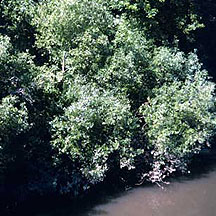|
Willows (Salix) 
- Leaves tend to be narrow and pointed (although some
are fatter and more rounded); they are generally yellow-green on top
and white below.
Simple, alternate, and deciduous, with a short stalk.
-
Fruit is a tiny dark seed
surrounded by a cottony tuft.
- Winter buds hug the twig and are covered by a
single caplike scale
- Yellow to green twigs have no true terminal bud;
during winter, twigs just die back to where the wood is hard enough to
withstand the cold temperatures.
As
a group, willows are easy to identify - in fact, pussy willows are one
of the first trees
that many of us learn. But distinguishing between different types of
willows, is a different story.The
reason is that there are so many willows - North America has approximately
90 different
types -
and that many of the species interbreed, with the offspring having
characteristics of both parents. As a result, most people are satisfied
knowing that a tree is a willow, and leave it at that.
Oregon's
Tree-Sized Willows:
- Scouler (mountain)
willow -probably
the most common willow in western North America. It not only grows
at low elevations but ascends higher mountains. In western Oregon
it often reaches 40' tall. Unlike other willows it thrives
away from water.
- Pacific (black)
willow -
a black-barked tree or large shrub found around wet places. Often
40'-60' tall, and abundant west of the Cascades at low and moderate
elevations.
Identification
is aided by two or more tiny nodules at the base of each leaf
blade.
- Peachleaf willow -
seen along streams and around farm homes in extreme northern and
eastern Oregon. Largest willow east of Cascades; grows to 70' tall.
- Hooker
willow - a
beach willow found the full length of the Northwest coast, and seldom
more than 5 miles from salt water. Its location and wide leaf improve
chances of identification. Grows along streams and on swampy
ground, near sea level.
- Northwest
willow - sometimes called sandbar willow. Has long, narrow leaves,
even ten times as long as wide. Occurs in western Oregon south
to the Klamath Mountains.
- Sitka willow - grows
mainly west of the Cascades, with scattered occurrences in eastern Oregon,
especially in Wallowas. Also called silky willow because of satiny
hairs on the undersides of its leaves. Some leaves have a pear-shape
outline.
For
more information on the willows native to the Pacific Northwest see "Trees
to Know in Oregon".
|
![]() trees
by common name
trees
by common name ![]() trees
by scientific name
trees
by scientific name ![]() dichotomous
key
dichotomous
key ![]() mystery
tree
mystery
tree ![]()
![]() website
authors
website
authors![]() order
a book "Trees to Know"
order
a book "Trees to Know"![]() more
informational sites
more
informational sites![]() contact us
contact us![]()